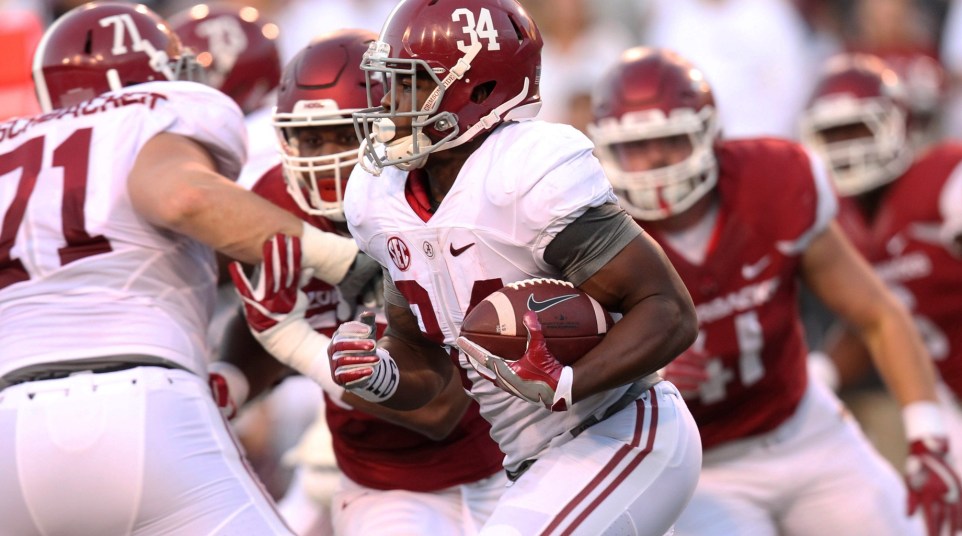
Rushing attack among Nick Saban's best so far at Alabama
After Alabama gashed Tennessee for 438 yards, the most by the program since 1986 (coincidentally also against Tennessee), a natural question has arisen: Is this the best rushing attack the school has fielded under Nick Saban?
It is a question without a definitive answer, as so much subjective qualities go into questions of “best.” Besides, the season is not yet completed, so giving a definitive answer at this point is plain silly.
Statistically, Alabama had a particularly strong running game in 2012. The 2012 team averaged 228 yards rushing per game, the highest total for Alabama under Saban. The team’s top four rushers totaled 2,898 yards by the end of the season. Eddie Lacy and T.J. Yeldon both surpassed the 1,000-yard mark, Kenyan Drake was the team’s third-leading rusher and Blake Sims was the team’s fourth-leading rusher.
It remains to be seen just how good this season’s three-pronged rushing attack will compare to that group, but at this point, the numbers look favorable. The team’s 266 yards rushing per game far eclipses the 2012 total. The team’s top four rushers have totaled 1,618 yards at this point in the season. If the team continues at the current average, it will reach 3,189 rushing yards by the end of the Iron Bowl, none of which takes into consideration a potential bowl game while also not considering LSU’s stingy run defense.
All of this is to state the case that, whether or not this is the “best” running offense for Alabama under Saban, the team’s numbers give it a shot to make a case. Certainly, the talent ranks at or near the top.
What is most likable about this Alabama group’s running attack is its versatility. Yes, the team runs predictable jet sweeps, and the jet sweeps are always either ArDarius Stewart or Calvin Ridley. Say what you will, the plays have actually had greater success as the season progresses. Perhaps it is due to better blocking or perfecting the play through repeated practices. Whatever the case, Stewart ran a variation of the play (in this instance, it was more of a jet sweep reverse) for a 29-yard touchdown on Saturday.
Past Alabama teams have been known for having physical running games, especially strong at running between the tackles. This season’s team attacks in a multitude of ways. For one thing, Alabama helps open up the running game with the aforementioned jet sweeps and other perimeter runs. Having an effective runner at quarterback in Jalen Hurts completely opens up the offense, and defenses must respect Hurts’ ability to run the ball.
The 2012 team had three running backs with different styles. Lacy was the tough, physical back, while Drake was the change-of-pace burst of speed. Yeldon was the back who could do it all. On this season’s team, Harris fits the Yeldon role. He’s proven he’s just as effective bouncing out to the edge or running between the tackles. Bo Scarbrough has done both effectively, too, although he is the more physical back. Jacobs is shifty and instinctual, the closest equivalent to Drake. However, let’s be clear: this season’s team is far different from the 2012 team.
In fact, the team has a tendency to make big plays on the edge because the greatest strength on the offensive line this season is at tackle. Cam Robinson and Jonah Williams have been instrumental in springing all four of the team’s leading rushers for big gains.
Harris is the team’s leading rusher with 572 rushing yards, while Hurts is the second-leading rusher with 428. Jacobs and Scarbrough have received far fewer carries but still have 345 and 273 rushing yards, respectively.
In Saturday’s game, Hurts had 132 rushing yards — second only to his 146 vs. Ole Miss — with 3 touchdowns and a career-long 45-yard run. Hurts has been the offensive dynamic that makes Alabama exciting and less predictable, while the opportunistic defense is perhaps even more exciting.
By rushing for a whopping 438 yards against Tennessee on Saturday, the team made many ask the question: Is this the best rushing attack under Saban? Time will tell.
